Research on Obesity in Australia: Distribution, Causes, and Effects
VerifiedAdded on 2023/06/09
|36
|5708
|266
Project
AI Summary
This research project delves into the critical issue of overweight and obesity in Australia, examining its distribution across various demographics, potential causes, and significant effects. The study analyzes data from various sources, including the Australian health department database, to investigate the rates of obesity and identify factors such as age, place of residence, and socioeconomic status that may contribute to the problem. The project explores the relationship between overweight and obesity, investigating whether overweight acts as a precursor to obesity. Furthermore, the research employs statistical tests and a conceptual framework to analyze the distribution of obesity among different social groups, comparing the rates of obesity between male and female children, as well as older males and females. The study also explores literature on the issue of obesity in developed countries. The project aims to offer insights into the issue and provide recommendations for potential remedies and preventive measures. The research includes a literature review, methodology section with data analysis, and discussion of the results, limitations, and future research directions, culminating in a conclusion on the extent of obesity in Australia.
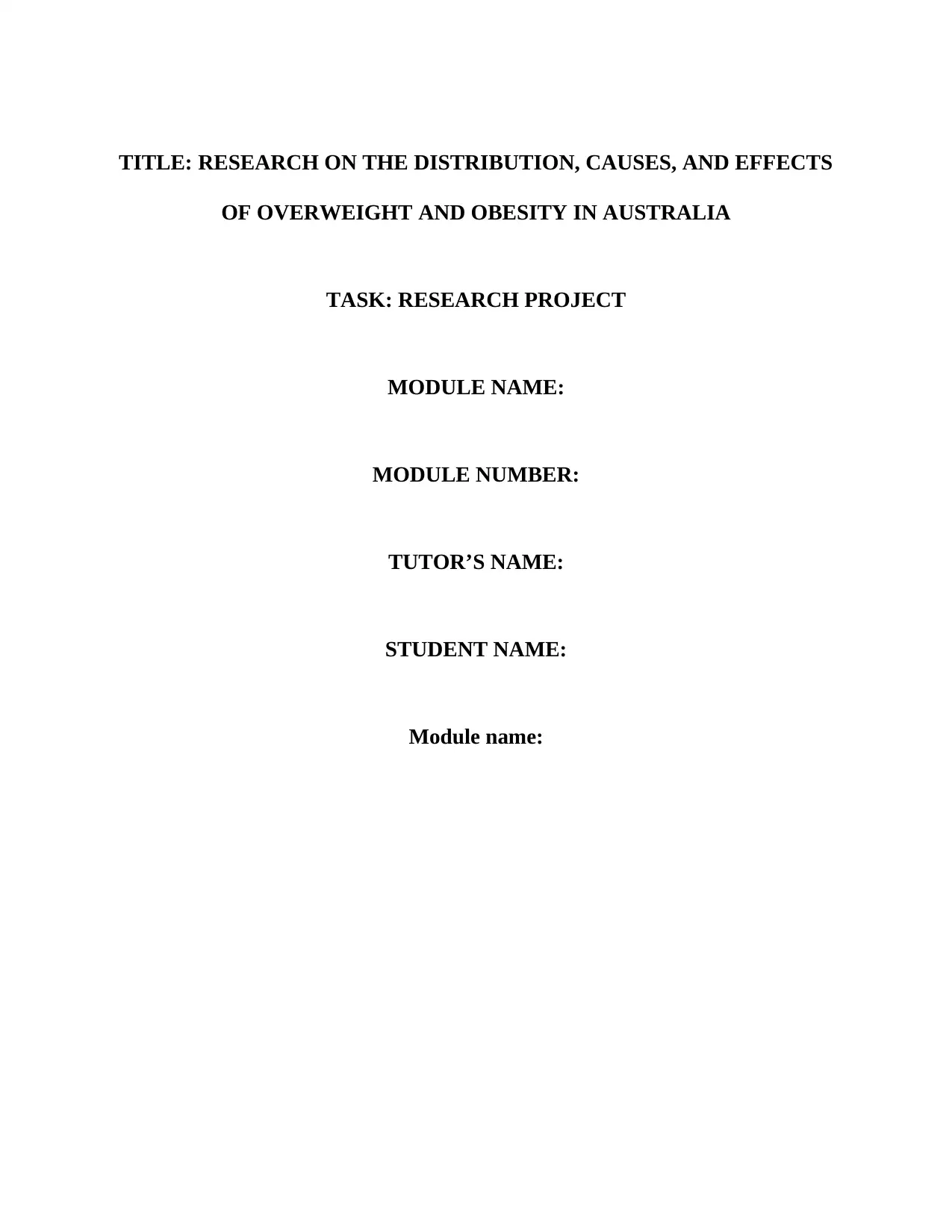
TITLE: RESEARCH ON THE DISTRIBUTION, CAUSES, AND EFFECTS
OF OVERWEIGHT AND OBESITY IN AUSTRALIA
TASK: RESEARCH PROJECT
MODULE NAME:
MODULE NUMBER:
TUTOR’S NAME:
STUDENT NAME:
Module name:
OF OVERWEIGHT AND OBESITY IN AUSTRALIA
TASK: RESEARCH PROJECT
MODULE NAME:
MODULE NUMBER:
TUTOR’S NAME:
STUDENT NAME:
Module name:
Paraphrase This Document
Need a fresh take? Get an instant paraphrase of this document with our AI Paraphraser
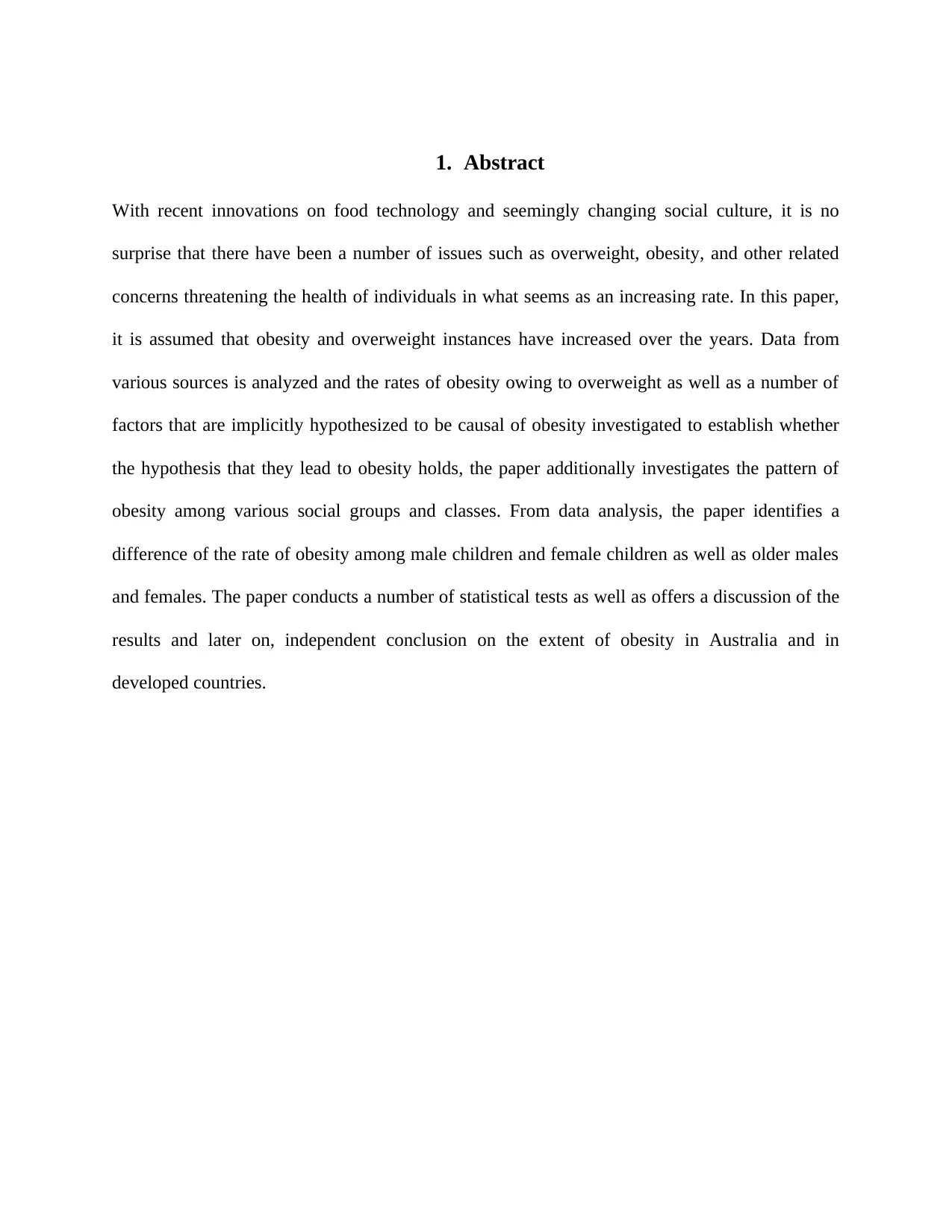
1. Abstract
With recent innovations on food technology and seemingly changing social culture, it is no
surprise that there have been a number of issues such as overweight, obesity, and other related
concerns threatening the health of individuals in what seems as an increasing rate. In this paper,
it is assumed that obesity and overweight instances have increased over the years. Data from
various sources is analyzed and the rates of obesity owing to overweight as well as a number of
factors that are implicitly hypothesized to be causal of obesity investigated to establish whether
the hypothesis that they lead to obesity holds, the paper additionally investigates the pattern of
obesity among various social groups and classes. From data analysis, the paper identifies a
difference of the rate of obesity among male children and female children as well as older males
and females. The paper conducts a number of statistical tests as well as offers a discussion of the
results and later on, independent conclusion on the extent of obesity in Australia and in
developed countries.
With recent innovations on food technology and seemingly changing social culture, it is no
surprise that there have been a number of issues such as overweight, obesity, and other related
concerns threatening the health of individuals in what seems as an increasing rate. In this paper,
it is assumed that obesity and overweight instances have increased over the years. Data from
various sources is analyzed and the rates of obesity owing to overweight as well as a number of
factors that are implicitly hypothesized to be causal of obesity investigated to establish whether
the hypothesis that they lead to obesity holds, the paper additionally investigates the pattern of
obesity among various social groups and classes. From data analysis, the paper identifies a
difference of the rate of obesity among male children and female children as well as older males
and females. The paper conducts a number of statistical tests as well as offers a discussion of the
results and later on, independent conclusion on the extent of obesity in Australia and in
developed countries.
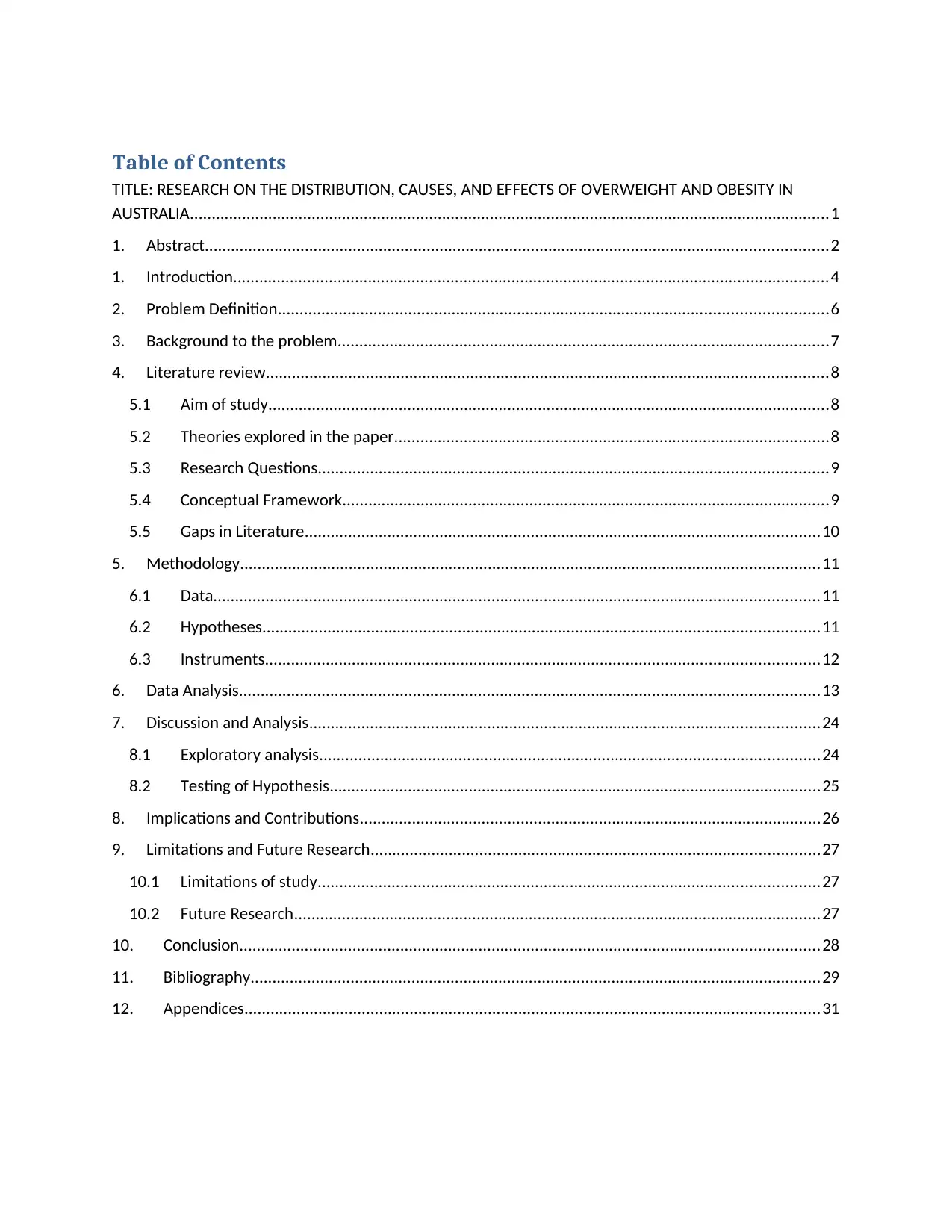
Table of Contents
TITLE: RESEARCH ON THE DISTRIBUTION, CAUSES, AND EFFECTS OF OVERWEIGHT AND OBESITY IN
AUSTRALIA...................................................................................................................................................1
1. Abstract...............................................................................................................................................2
1. Introduction.........................................................................................................................................4
2. Problem Definition..............................................................................................................................6
3. Background to the problem.................................................................................................................7
4. Literature review.................................................................................................................................8
5.1 Aim of study.................................................................................................................................8
5.2 Theories explored in the paper....................................................................................................8
5.3 Research Questions.....................................................................................................................9
5.4 Conceptual Framework................................................................................................................9
5.5 Gaps in Literature......................................................................................................................10
5. Methodology.....................................................................................................................................11
6.1 Data...........................................................................................................................................11
6.2 Hypotheses................................................................................................................................11
6.3 Instruments...............................................................................................................................12
6. Data Analysis.....................................................................................................................................13
7. Discussion and Analysis.....................................................................................................................24
8.1 Exploratory analysis...................................................................................................................24
8.2 Testing of Hypothesis.................................................................................................................25
8. Implications and Contributions..........................................................................................................26
9. Limitations and Future Research.......................................................................................................27
10.1 Limitations of study...................................................................................................................27
10.2 Future Research.........................................................................................................................27
10. Conclusion.....................................................................................................................................28
11. Bibliography...................................................................................................................................29
12. Appendices....................................................................................................................................31
TITLE: RESEARCH ON THE DISTRIBUTION, CAUSES, AND EFFECTS OF OVERWEIGHT AND OBESITY IN
AUSTRALIA...................................................................................................................................................1
1. Abstract...............................................................................................................................................2
1. Introduction.........................................................................................................................................4
2. Problem Definition..............................................................................................................................6
3. Background to the problem.................................................................................................................7
4. Literature review.................................................................................................................................8
5.1 Aim of study.................................................................................................................................8
5.2 Theories explored in the paper....................................................................................................8
5.3 Research Questions.....................................................................................................................9
5.4 Conceptual Framework................................................................................................................9
5.5 Gaps in Literature......................................................................................................................10
5. Methodology.....................................................................................................................................11
6.1 Data...........................................................................................................................................11
6.2 Hypotheses................................................................................................................................11
6.3 Instruments...............................................................................................................................12
6. Data Analysis.....................................................................................................................................13
7. Discussion and Analysis.....................................................................................................................24
8.1 Exploratory analysis...................................................................................................................24
8.2 Testing of Hypothesis.................................................................................................................25
8. Implications and Contributions..........................................................................................................26
9. Limitations and Future Research.......................................................................................................27
10.1 Limitations of study...................................................................................................................27
10.2 Future Research.........................................................................................................................27
10. Conclusion.....................................................................................................................................28
11. Bibliography...................................................................................................................................29
12. Appendices....................................................................................................................................31
⊘ This is a preview!⊘
Do you want full access?
Subscribe today to unlock all pages.

Trusted by 1+ million students worldwide
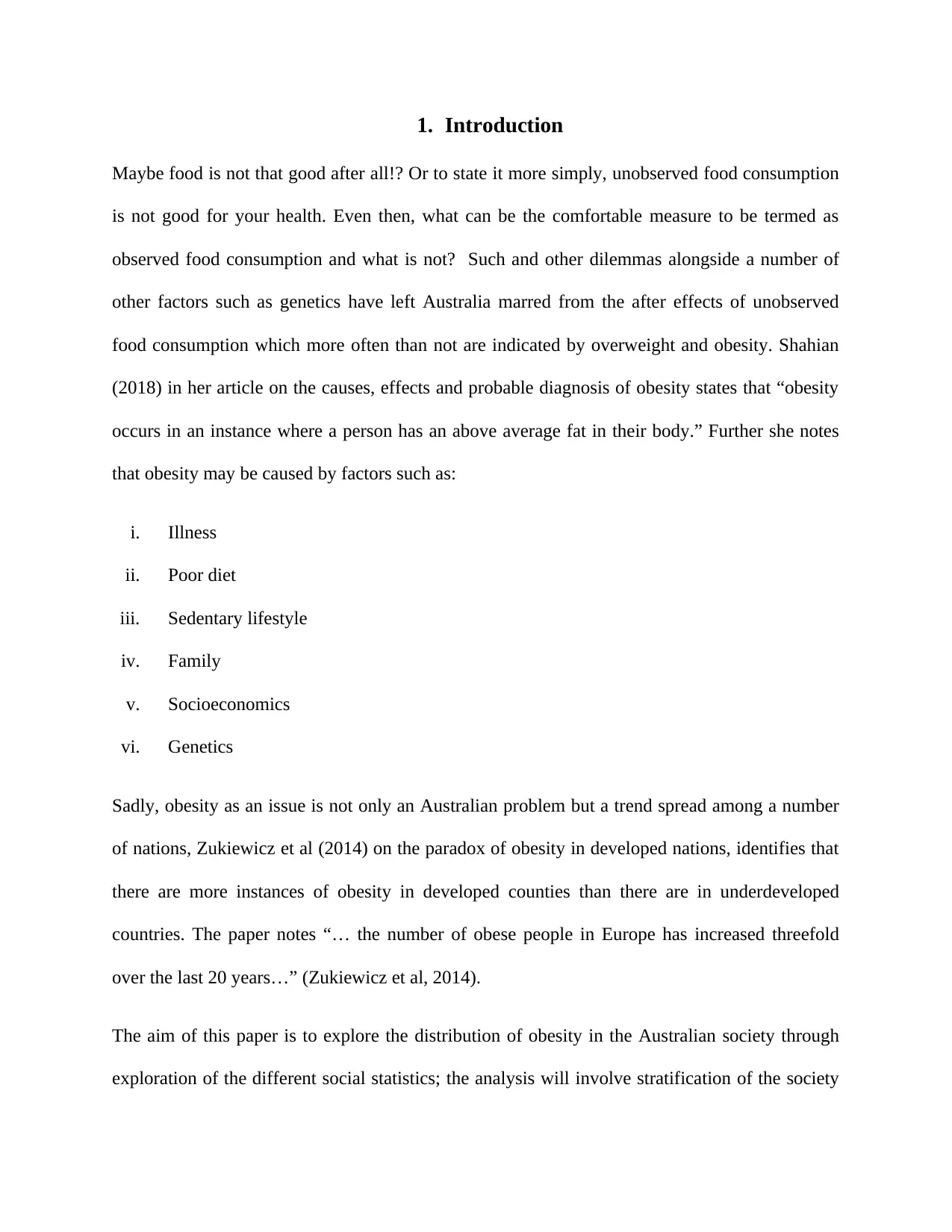
1. Introduction
Maybe food is not that good after all!? Or to state it more simply, unobserved food consumption
is not good for your health. Even then, what can be the comfortable measure to be termed as
observed food consumption and what is not? Such and other dilemmas alongside a number of
other factors such as genetics have left Australia marred from the after effects of unobserved
food consumption which more often than not are indicated by overweight and obesity. Shahian
(2018) in her article on the causes, effects and probable diagnosis of obesity states that “obesity
occurs in an instance where a person has an above average fat in their body.” Further she notes
that obesity may be caused by factors such as:
i. Illness
ii. Poor diet
iii. Sedentary lifestyle
iv. Family
v. Socioeconomics
vi. Genetics
Sadly, obesity as an issue is not only an Australian problem but a trend spread among a number
of nations, Zukiewicz et al (2014) on the paradox of obesity in developed nations, identifies that
there are more instances of obesity in developed counties than there are in underdeveloped
countries. The paper notes “… the number of obese people in Europe has increased threefold
over the last 20 years…” (Zukiewicz et al, 2014).
The aim of this paper is to explore the distribution of obesity in the Australian society through
exploration of the different social statistics; the analysis will involve stratification of the society
Maybe food is not that good after all!? Or to state it more simply, unobserved food consumption
is not good for your health. Even then, what can be the comfortable measure to be termed as
observed food consumption and what is not? Such and other dilemmas alongside a number of
other factors such as genetics have left Australia marred from the after effects of unobserved
food consumption which more often than not are indicated by overweight and obesity. Shahian
(2018) in her article on the causes, effects and probable diagnosis of obesity states that “obesity
occurs in an instance where a person has an above average fat in their body.” Further she notes
that obesity may be caused by factors such as:
i. Illness
ii. Poor diet
iii. Sedentary lifestyle
iv. Family
v. Socioeconomics
vi. Genetics
Sadly, obesity as an issue is not only an Australian problem but a trend spread among a number
of nations, Zukiewicz et al (2014) on the paradox of obesity in developed nations, identifies that
there are more instances of obesity in developed counties than there are in underdeveloped
countries. The paper notes “… the number of obese people in Europe has increased threefold
over the last 20 years…” (Zukiewicz et al, 2014).
The aim of this paper is to explore the distribution of obesity in the Australian society through
exploration of the different social statistics; the analysis will involve stratification of the society
Paraphrase This Document
Need a fresh take? Get an instant paraphrase of this document with our AI Paraphraser
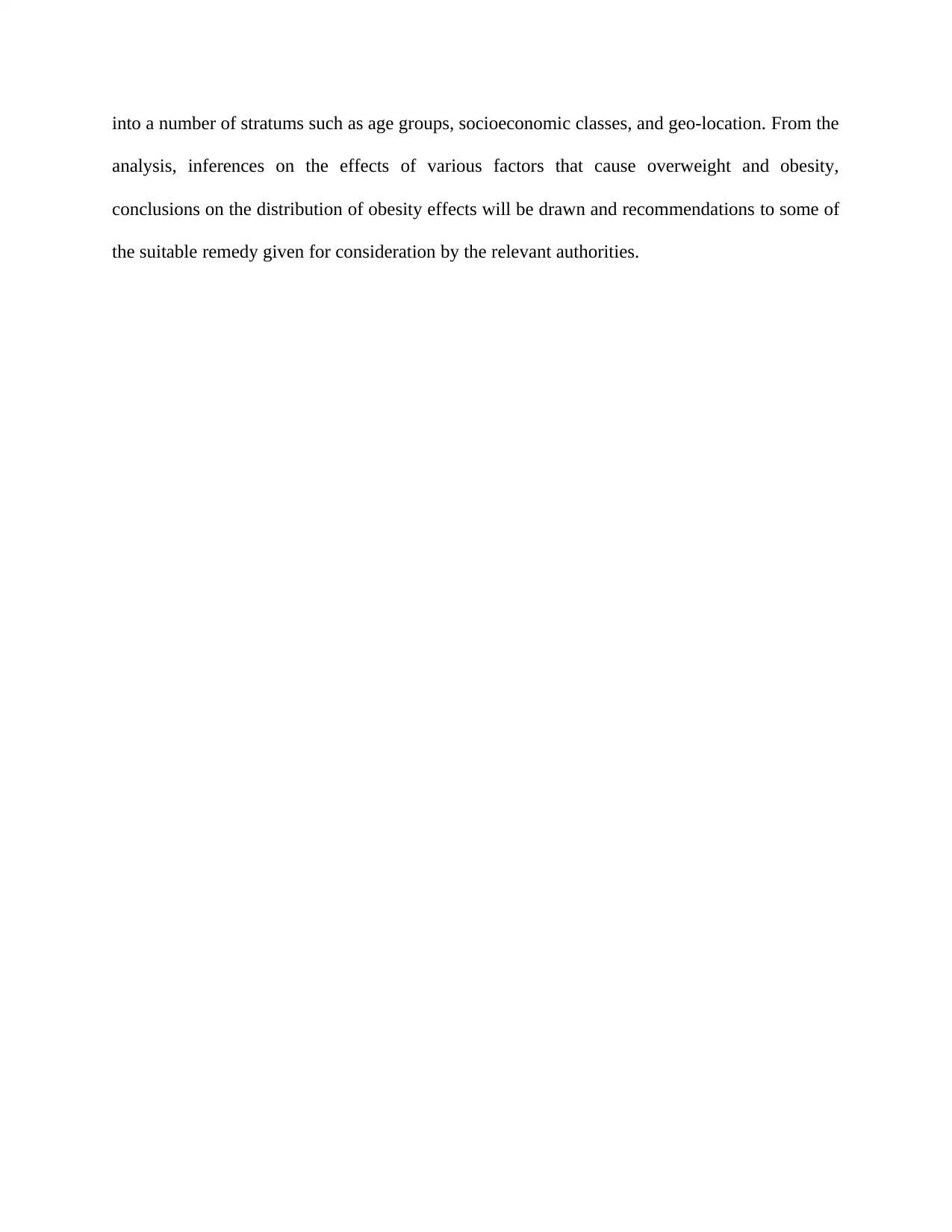
into a number of stratums such as age groups, socioeconomic classes, and geo-location. From the
analysis, inferences on the effects of various factors that cause overweight and obesity,
conclusions on the distribution of obesity effects will be drawn and recommendations to some of
the suitable remedy given for consideration by the relevant authorities.
analysis, inferences on the effects of various factors that cause overweight and obesity,
conclusions on the distribution of obesity effects will be drawn and recommendations to some of
the suitable remedy given for consideration by the relevant authorities.
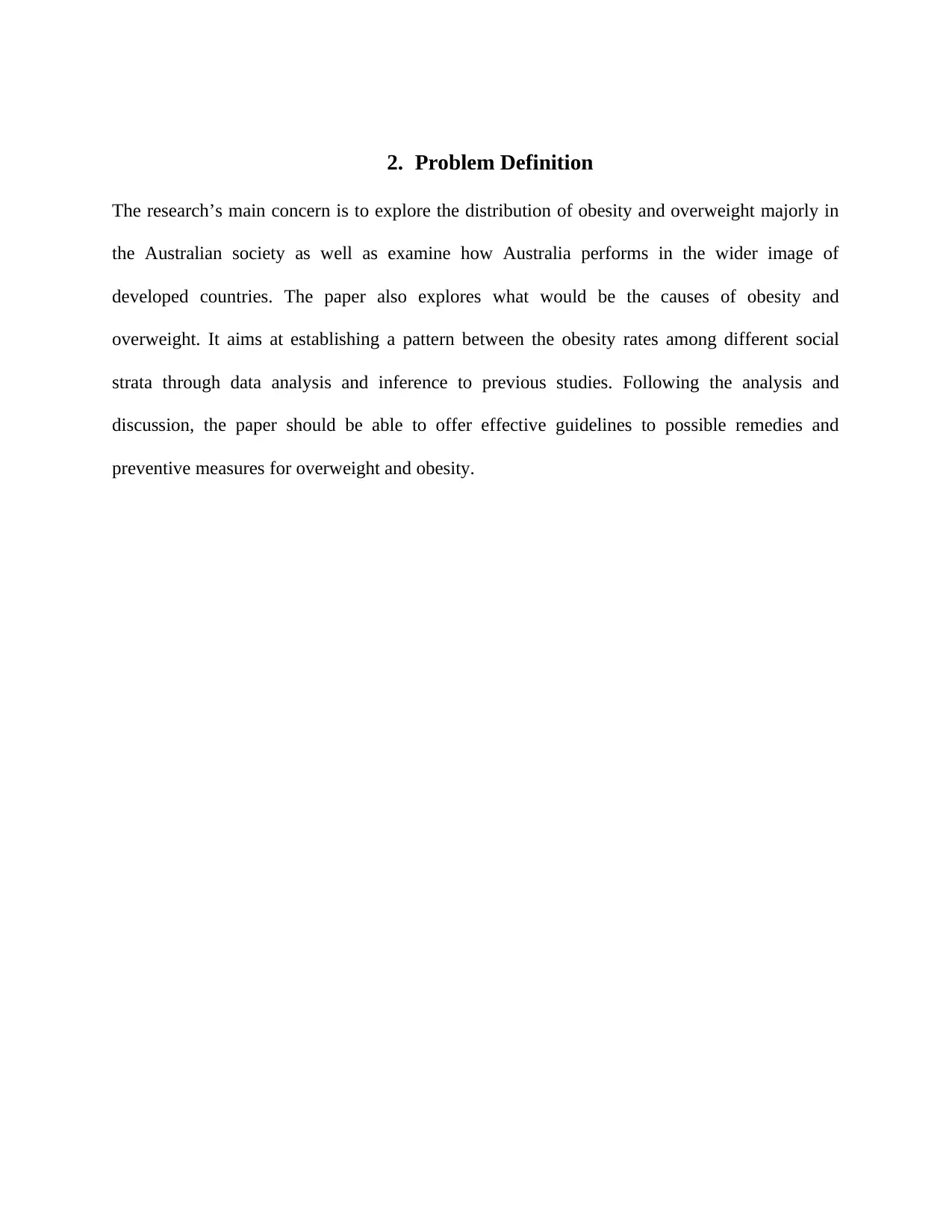
2. Problem Definition
The research’s main concern is to explore the distribution of obesity and overweight majorly in
the Australian society as well as examine how Australia performs in the wider image of
developed countries. The paper also explores what would be the causes of obesity and
overweight. It aims at establishing a pattern between the obesity rates among different social
strata through data analysis and inference to previous studies. Following the analysis and
discussion, the paper should be able to offer effective guidelines to possible remedies and
preventive measures for overweight and obesity.
The research’s main concern is to explore the distribution of obesity and overweight majorly in
the Australian society as well as examine how Australia performs in the wider image of
developed countries. The paper also explores what would be the causes of obesity and
overweight. It aims at establishing a pattern between the obesity rates among different social
strata through data analysis and inference to previous studies. Following the analysis and
discussion, the paper should be able to offer effective guidelines to possible remedies and
preventive measures for overweight and obesity.
⊘ This is a preview!⊘
Do you want full access?
Subscribe today to unlock all pages.

Trusted by 1+ million students worldwide
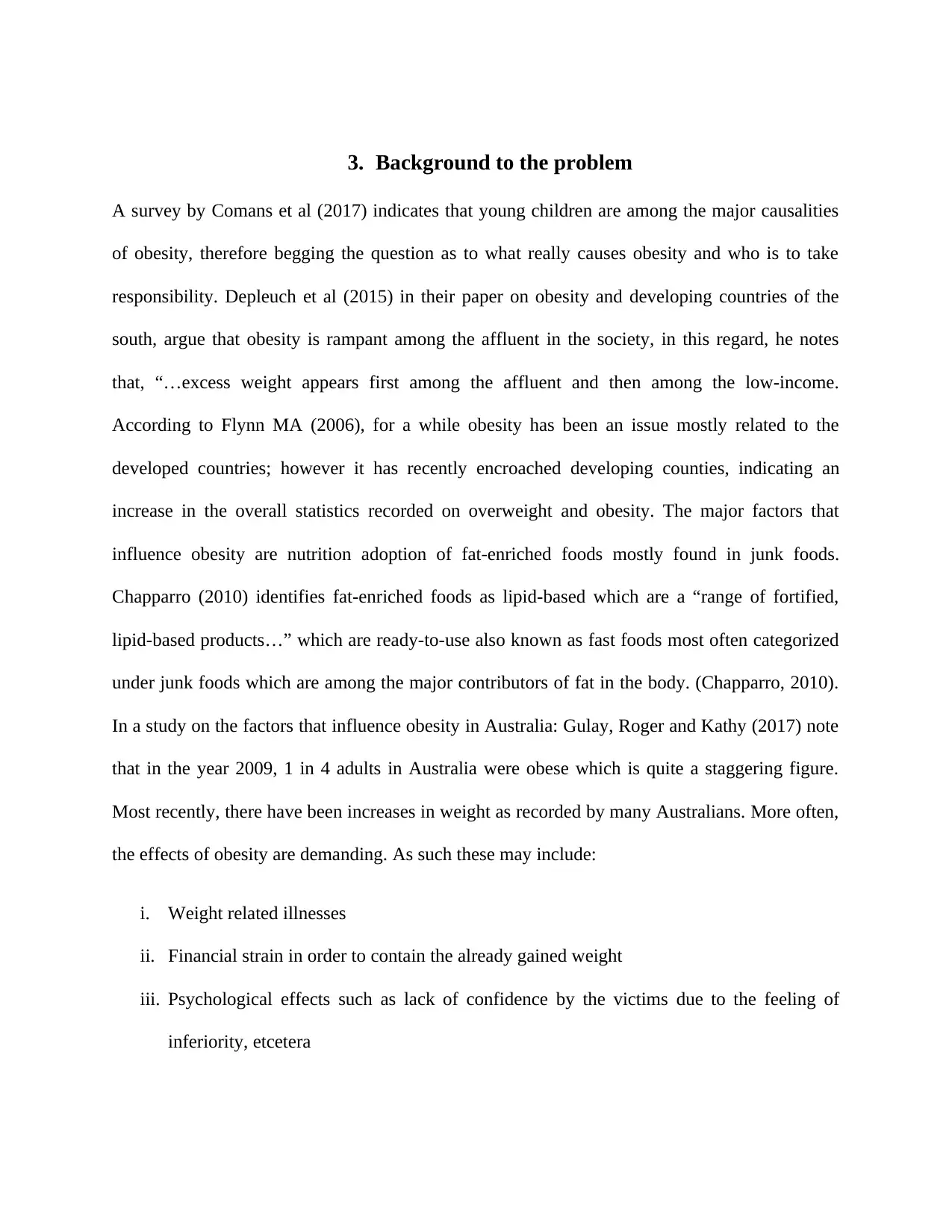
3. Background to the problem
A survey by Comans et al (2017) indicates that young children are among the major causalities
of obesity, therefore begging the question as to what really causes obesity and who is to take
responsibility. Depleuch et al (2015) in their paper on obesity and developing countries of the
south, argue that obesity is rampant among the affluent in the society, in this regard, he notes
that, “…excess weight appears first among the affluent and then among the low-income.
According to Flynn MA (2006), for a while obesity has been an issue mostly related to the
developed countries; however it has recently encroached developing counties, indicating an
increase in the overall statistics recorded on overweight and obesity. The major factors that
influence obesity are nutrition adoption of fat-enriched foods mostly found in junk foods.
Chapparro (2010) identifies fat-enriched foods as lipid-based which are a “range of fortified,
lipid-based products…” which are ready-to-use also known as fast foods most often categorized
under junk foods which are among the major contributors of fat in the body. (Chapparro, 2010).
In a study on the factors that influence obesity in Australia: Gulay, Roger and Kathy (2017) note
that in the year 2009, 1 in 4 adults in Australia were obese which is quite a staggering figure.
Most recently, there have been increases in weight as recorded by many Australians. More often,
the effects of obesity are demanding. As such these may include:
i. Weight related illnesses
ii. Financial strain in order to contain the already gained weight
iii. Psychological effects such as lack of confidence by the victims due to the feeling of
inferiority, etcetera
A survey by Comans et al (2017) indicates that young children are among the major causalities
of obesity, therefore begging the question as to what really causes obesity and who is to take
responsibility. Depleuch et al (2015) in their paper on obesity and developing countries of the
south, argue that obesity is rampant among the affluent in the society, in this regard, he notes
that, “…excess weight appears first among the affluent and then among the low-income.
According to Flynn MA (2006), for a while obesity has been an issue mostly related to the
developed countries; however it has recently encroached developing counties, indicating an
increase in the overall statistics recorded on overweight and obesity. The major factors that
influence obesity are nutrition adoption of fat-enriched foods mostly found in junk foods.
Chapparro (2010) identifies fat-enriched foods as lipid-based which are a “range of fortified,
lipid-based products…” which are ready-to-use also known as fast foods most often categorized
under junk foods which are among the major contributors of fat in the body. (Chapparro, 2010).
In a study on the factors that influence obesity in Australia: Gulay, Roger and Kathy (2017) note
that in the year 2009, 1 in 4 adults in Australia were obese which is quite a staggering figure.
Most recently, there have been increases in weight as recorded by many Australians. More often,
the effects of obesity are demanding. As such these may include:
i. Weight related illnesses
ii. Financial strain in order to contain the already gained weight
iii. Psychological effects such as lack of confidence by the victims due to the feeling of
inferiority, etcetera
Paraphrase This Document
Need a fresh take? Get an instant paraphrase of this document with our AI Paraphraser
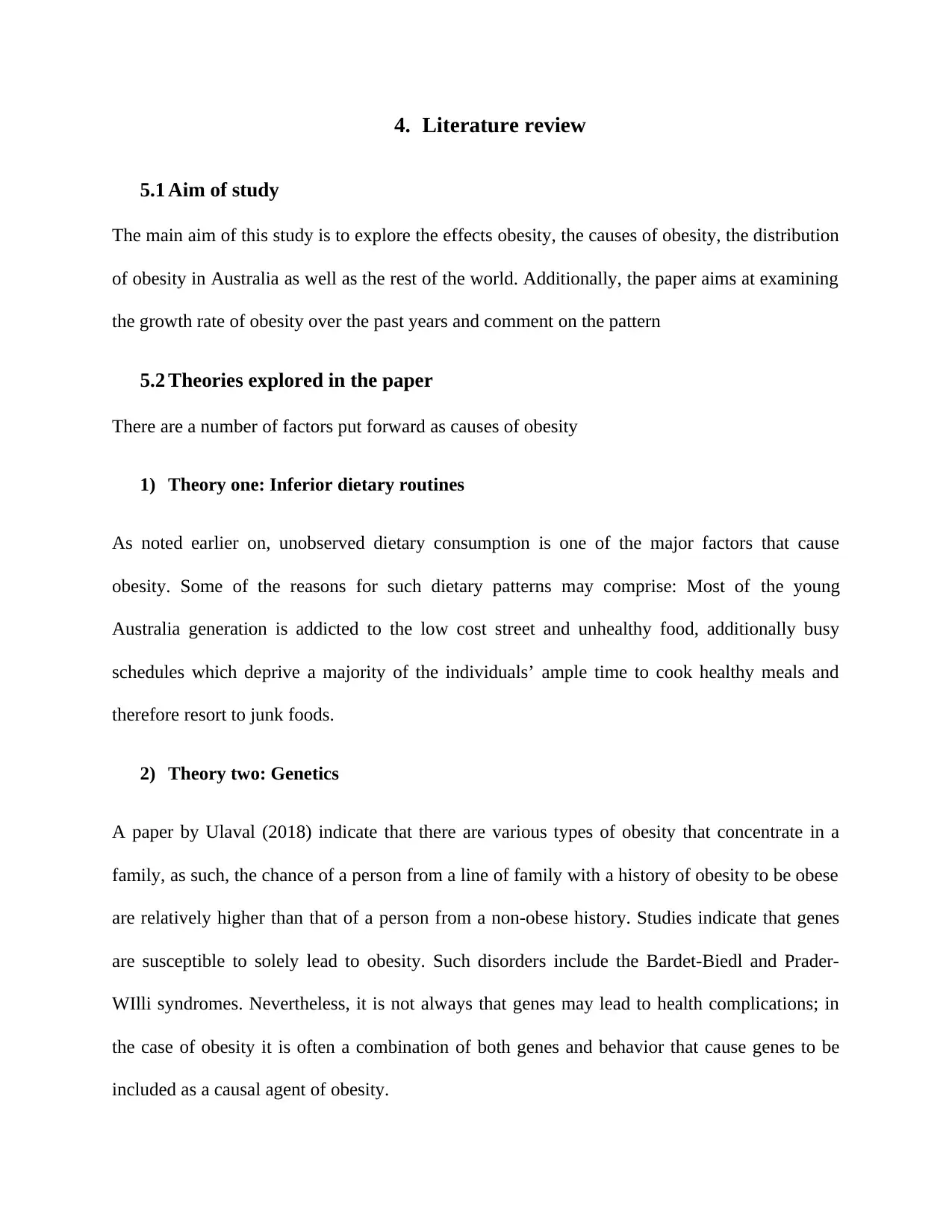
4. Literature review
5.1 Aim of study
The main aim of this study is to explore the effects obesity, the causes of obesity, the distribution
of obesity in Australia as well as the rest of the world. Additionally, the paper aims at examining
the growth rate of obesity over the past years and comment on the pattern
5.2 Theories explored in the paper
There are a number of factors put forward as causes of obesity
1) Theory one: Inferior dietary routines
As noted earlier on, unobserved dietary consumption is one of the major factors that cause
obesity. Some of the reasons for such dietary patterns may comprise: Most of the young
Australia generation is addicted to the low cost street and unhealthy food, additionally busy
schedules which deprive a majority of the individuals’ ample time to cook healthy meals and
therefore resort to junk foods.
2) Theory two: Genetics
A paper by Ulaval (2018) indicate that there are various types of obesity that concentrate in a
family, as such, the chance of a person from a line of family with a history of obesity to be obese
are relatively higher than that of a person from a non-obese history. Studies indicate that genes
are susceptible to solely lead to obesity. Such disorders include the Bardet-Biedl and Prader-
WIlli syndromes. Nevertheless, it is not always that genes may lead to health complications; in
the case of obesity it is often a combination of both genes and behavior that cause genes to be
included as a causal agent of obesity.
5.1 Aim of study
The main aim of this study is to explore the effects obesity, the causes of obesity, the distribution
of obesity in Australia as well as the rest of the world. Additionally, the paper aims at examining
the growth rate of obesity over the past years and comment on the pattern
5.2 Theories explored in the paper
There are a number of factors put forward as causes of obesity
1) Theory one: Inferior dietary routines
As noted earlier on, unobserved dietary consumption is one of the major factors that cause
obesity. Some of the reasons for such dietary patterns may comprise: Most of the young
Australia generation is addicted to the low cost street and unhealthy food, additionally busy
schedules which deprive a majority of the individuals’ ample time to cook healthy meals and
therefore resort to junk foods.
2) Theory two: Genetics
A paper by Ulaval (2018) indicate that there are various types of obesity that concentrate in a
family, as such, the chance of a person from a line of family with a history of obesity to be obese
are relatively higher than that of a person from a non-obese history. Studies indicate that genes
are susceptible to solely lead to obesity. Such disorders include the Bardet-Biedl and Prader-
WIlli syndromes. Nevertheless, it is not always that genes may lead to health complications; in
the case of obesity it is often a combination of both genes and behavior that cause genes to be
included as a causal agent of obesity.
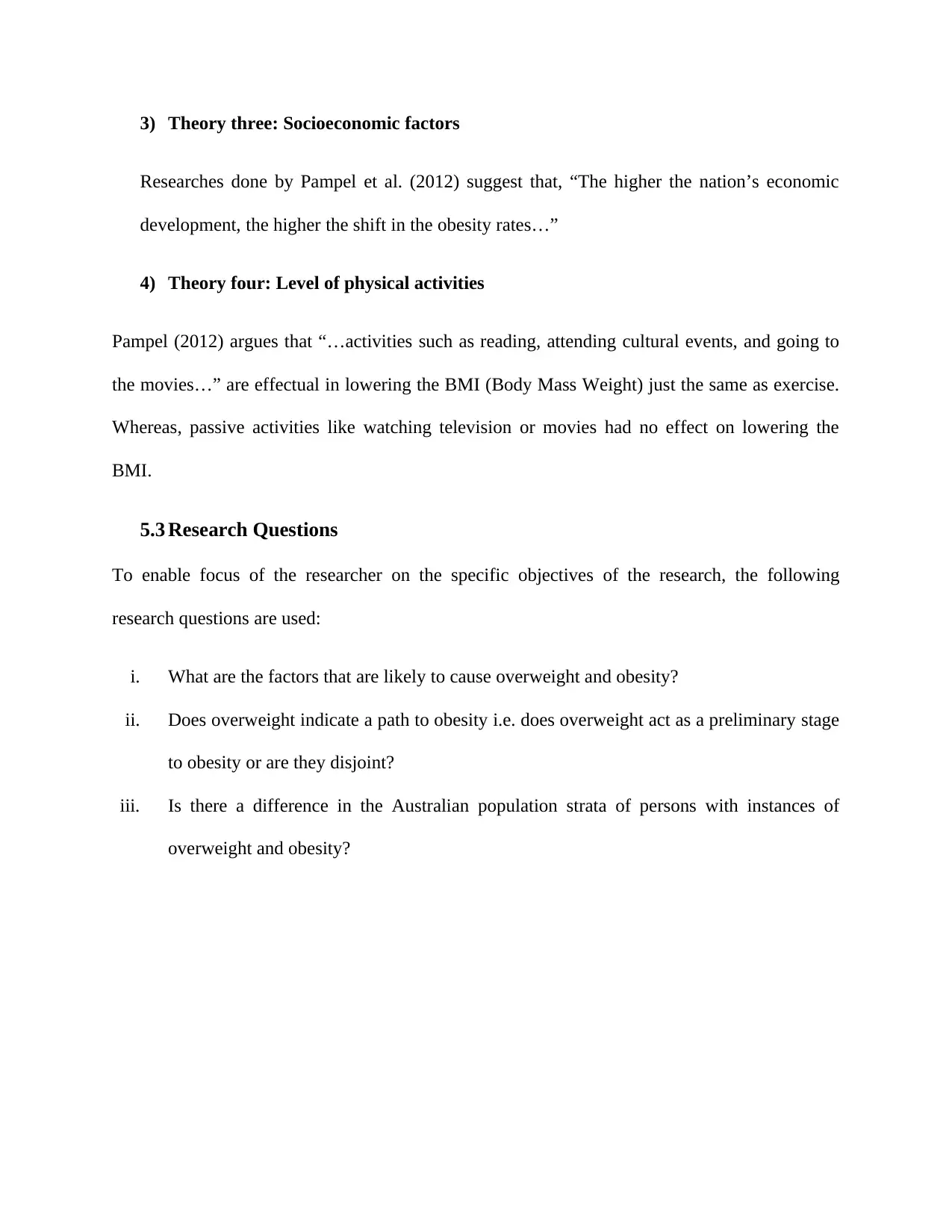
3) Theory three: Socioeconomic factors
Researches done by Pampel et al. (2012) suggest that, “The higher the nation’s economic
development, the higher the shift in the obesity rates…”
4) Theory four: Level of physical activities
Pampel (2012) argues that “…activities such as reading, attending cultural events, and going to
the movies…” are effectual in lowering the BMI (Body Mass Weight) just the same as exercise.
Whereas, passive activities like watching television or movies had no effect on lowering the
BMI.
5.3 Research Questions
To enable focus of the researcher on the specific objectives of the research, the following
research questions are used:
i. What are the factors that are likely to cause overweight and obesity?
ii. Does overweight indicate a path to obesity i.e. does overweight act as a preliminary stage
to obesity or are they disjoint?
iii. Is there a difference in the Australian population strata of persons with instances of
overweight and obesity?
Researches done by Pampel et al. (2012) suggest that, “The higher the nation’s economic
development, the higher the shift in the obesity rates…”
4) Theory four: Level of physical activities
Pampel (2012) argues that “…activities such as reading, attending cultural events, and going to
the movies…” are effectual in lowering the BMI (Body Mass Weight) just the same as exercise.
Whereas, passive activities like watching television or movies had no effect on lowering the
BMI.
5.3 Research Questions
To enable focus of the researcher on the specific objectives of the research, the following
research questions are used:
i. What are the factors that are likely to cause overweight and obesity?
ii. Does overweight indicate a path to obesity i.e. does overweight act as a preliminary stage
to obesity or are they disjoint?
iii. Is there a difference in the Australian population strata of persons with instances of
overweight and obesity?
⊘ This is a preview!⊘
Do you want full access?
Subscribe today to unlock all pages.

Trusted by 1+ million students worldwide
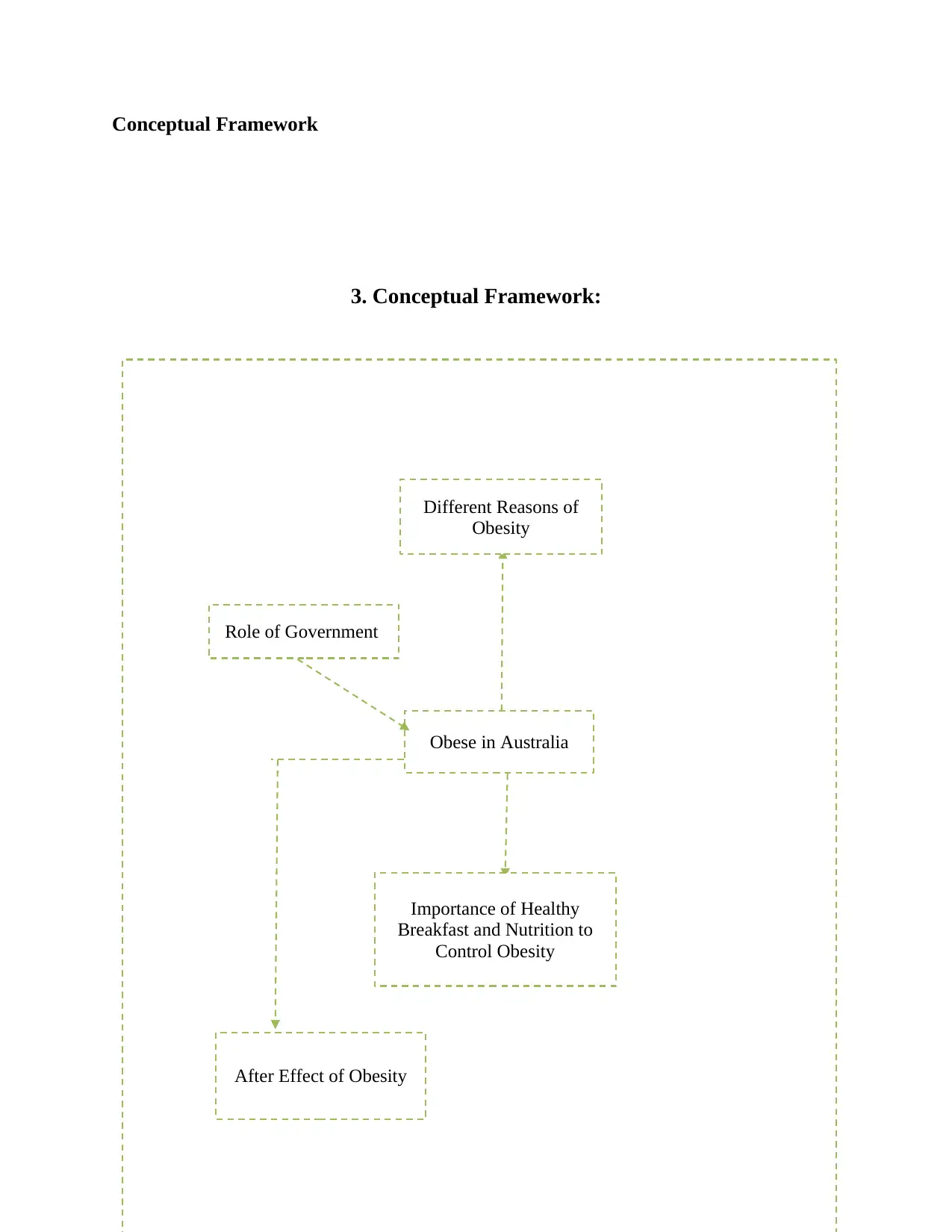
Obese in Australia
Different Reasons of
Obesity
Importance of Healthy
Breakfast and Nutrition to
Control Obesity
Role of Government
After Effect of Obesity
Conceptual Framework
3. Conceptual Framework:
Different Reasons of
Obesity
Importance of Healthy
Breakfast and Nutrition to
Control Obesity
Role of Government
After Effect of Obesity
Conceptual Framework
3. Conceptual Framework:
Paraphrase This Document
Need a fresh take? Get an instant paraphrase of this document with our AI Paraphraser
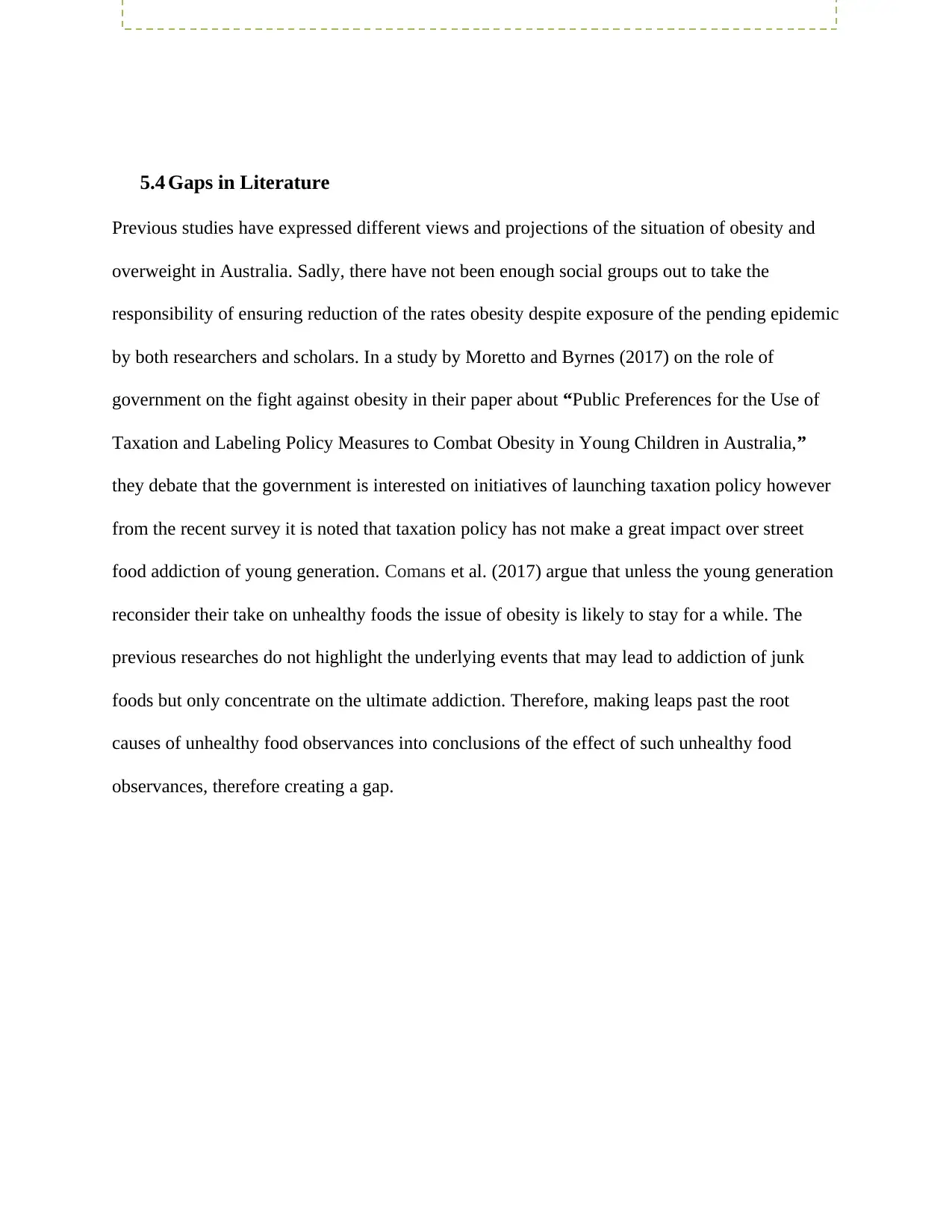
5.4 Gaps in Literature
Previous studies have expressed different views and projections of the situation of obesity and
overweight in Australia. Sadly, there have not been enough social groups out to take the
responsibility of ensuring reduction of the rates obesity despite exposure of the pending epidemic
by both researchers and scholars. In a study by Moretto and Byrnes (2017) on the role of
government on the fight against obesity in their paper about “Public Preferences for the Use of
Taxation and Labeling Policy Measures to Combat Obesity in Young Children in Australia,”
they debate that the government is interested on initiatives of launching taxation policy however
from the recent survey it is noted that taxation policy has not make a great impact over street
food addiction of young generation. Comans et al. (2017) argue that unless the young generation
reconsider their take on unhealthy foods the issue of obesity is likely to stay for a while. The
previous researches do not highlight the underlying events that may lead to addiction of junk
foods but only concentrate on the ultimate addiction. Therefore, making leaps past the root
causes of unhealthy food observances into conclusions of the effect of such unhealthy food
observances, therefore creating a gap.
Previous studies have expressed different views and projections of the situation of obesity and
overweight in Australia. Sadly, there have not been enough social groups out to take the
responsibility of ensuring reduction of the rates obesity despite exposure of the pending epidemic
by both researchers and scholars. In a study by Moretto and Byrnes (2017) on the role of
government on the fight against obesity in their paper about “Public Preferences for the Use of
Taxation and Labeling Policy Measures to Combat Obesity in Young Children in Australia,”
they debate that the government is interested on initiatives of launching taxation policy however
from the recent survey it is noted that taxation policy has not make a great impact over street
food addiction of young generation. Comans et al. (2017) argue that unless the young generation
reconsider their take on unhealthy foods the issue of obesity is likely to stay for a while. The
previous researches do not highlight the underlying events that may lead to addiction of junk
foods but only concentrate on the ultimate addiction. Therefore, making leaps past the root
causes of unhealthy food observances into conclusions of the effect of such unhealthy food
observances, therefore creating a gap.
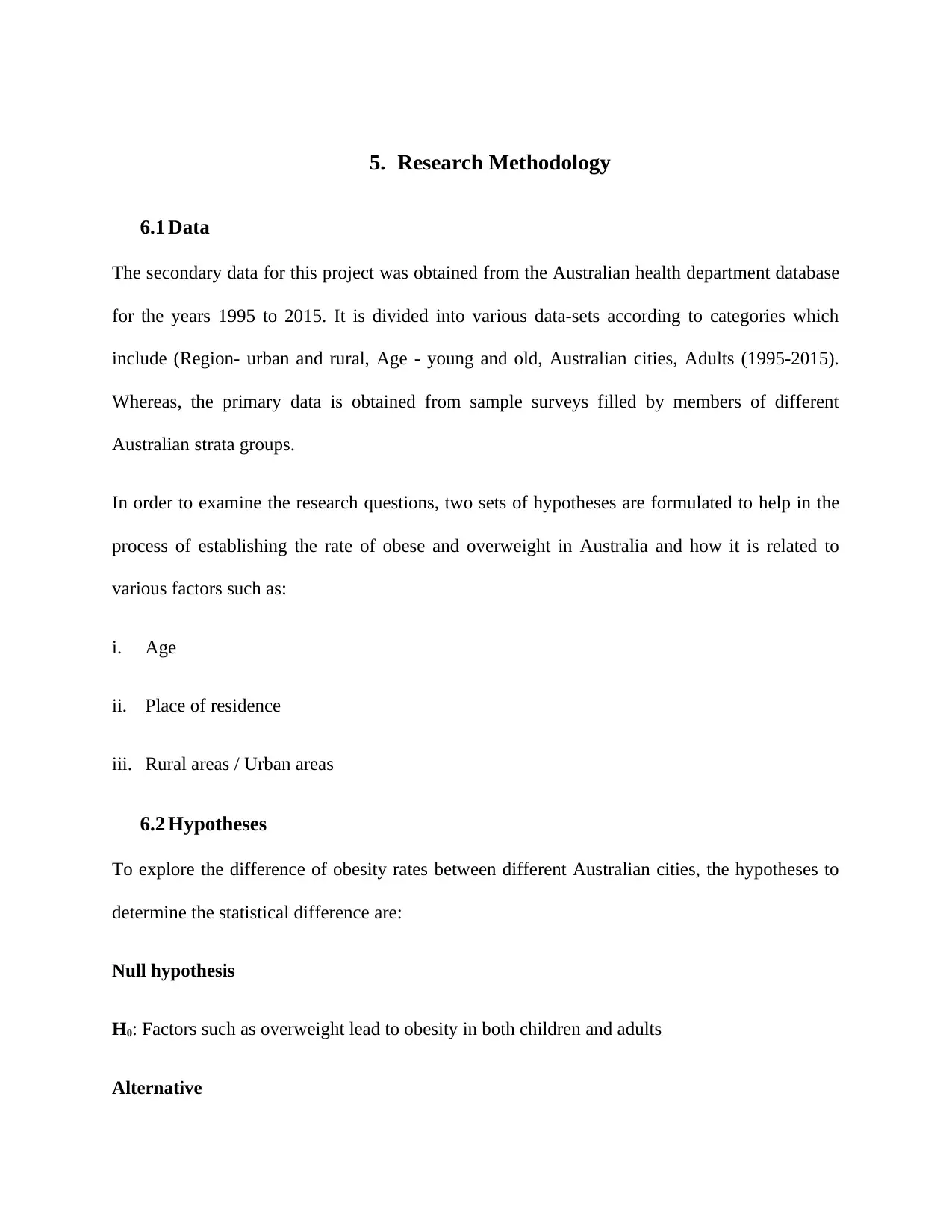
5. Research Methodology
6.1 Data
The secondary data for this project was obtained from the Australian health department database
for the years 1995 to 2015. It is divided into various data-sets according to categories which
include (Region- urban and rural, Age - young and old, Australian cities, Adults (1995-2015).
Whereas, the primary data is obtained from sample surveys filled by members of different
Australian strata groups.
In order to examine the research questions, two sets of hypotheses are formulated to help in the
process of establishing the rate of obese and overweight in Australia and how it is related to
various factors such as:
i. Age
ii. Place of residence
iii. Rural areas / Urban areas
6.2 Hypotheses
To explore the difference of obesity rates between different Australian cities, the hypotheses to
determine the statistical difference are:
Null hypothesis
H0: Factors such as overweight lead to obesity in both children and adults
Alternative
6.1 Data
The secondary data for this project was obtained from the Australian health department database
for the years 1995 to 2015. It is divided into various data-sets according to categories which
include (Region- urban and rural, Age - young and old, Australian cities, Adults (1995-2015).
Whereas, the primary data is obtained from sample surveys filled by members of different
Australian strata groups.
In order to examine the research questions, two sets of hypotheses are formulated to help in the
process of establishing the rate of obese and overweight in Australia and how it is related to
various factors such as:
i. Age
ii. Place of residence
iii. Rural areas / Urban areas
6.2 Hypotheses
To explore the difference of obesity rates between different Australian cities, the hypotheses to
determine the statistical difference are:
Null hypothesis
H0: Factors such as overweight lead to obesity in both children and adults
Alternative
⊘ This is a preview!⊘
Do you want full access?
Subscribe today to unlock all pages.

Trusted by 1+ million students worldwide
1 out of 36
Related Documents
Your All-in-One AI-Powered Toolkit for Academic Success.
+13062052269
info@desklib.com
Available 24*7 on WhatsApp / Email
![[object Object]](/_next/static/media/star-bottom.7253800d.svg)
Unlock your academic potential
Copyright © 2020–2025 A2Z Services. All Rights Reserved. Developed and managed by ZUCOL.





